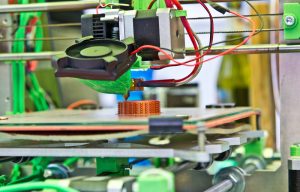To print three-dimensional pieces there is a need for laser-based additive manufacturing (AM); a process that distributes precise amounts of material, layer by layer to make the three dimensional item. 3-D printing works on a model different from traditional printing in that rather than “milling an item from a solid block” additive manufacturing uses powder that builds on upon itself, in individual layers to form the final product.
The powder is heated by a laser beam to melt it and convert it into a workable form. The layers of powder that are laid down fuse during the process. While “3-D printing” is the popular and most widely-used term, the more accurate terminology is “additive manufacturing.” The reason AM is more widely used in the technical industry is because it “captures the method’s distinct difference from conventional approaches to materials removal.”
The critical elements in this process include the laser source, the source if its power, the size of the spot being heated and the focal point of the finished product. These variables must all work together, be properly calibrated and controlled in order to realize a fully formed and functional final product.
As a research project, the Center for Innovative Materials Processing in Pennsylvania conducted a beam diagnostic test to evaluate the laser used in the AM processes. Researchers first determined that the power level selected was accurate and that the resulting power matched what was needed to manufacture the component.
Several tests were conducted and during each, the laser power was increased in 100 W increments, with a starting point of 100 and an ending point of 500 W. The power input was recorded at every step. As anticipated, the measurement data collected showed the actual power delivered was lower than the set point which means in order to achieve a 100 W set point, the operator needs to factor in the difference between set and delivered. The discrepancy between set point and delivered point varied by as much as 11 percent up to close to 30 percent, this points to the fact that individuals using the AM process need to carefully calibrate and test their laser before attempting to create a three dimensional product.
The next test involved measuring the focal point of the beam and the density of that beam. Ultimately, the testing showed the connection between the laser beam power lost between the set point and the substrate, allowed for the laser beams’ spatial energy distribution to be measured and allowed the user to more fully define an AM process that would deliver repeatable, quality results.
UKA Optics manufactures lenses for diode laser collimators, 3D Printers, CD and DVD players, laser pointers, laser levels, laser surface inspection systems and positioning and measuring equipment, standard and custom laser lens assemblies.